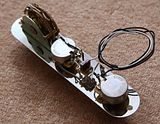Re: Vitamin Q 0.022
Yes, I know.
These combined with any op amp in that area, by virtue of electronic design rules , will not differ much from a TS808.
Originally posted by DreX
View Post
805 Drive
Specifications
Distortion Circuitry: Glass diode, back-to-back stack
Specifications
Distortion Circuitry: Glass diode, back-to-back stack




Comment